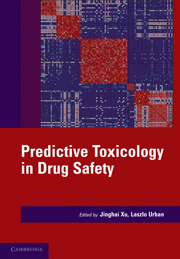Book contents
- Frontmatter
- Contents
- Contributors
- Prologue – Predictive toxicology: a new chapter in drug safety evaluation
- PREDICTIVE TOXICOLOGY IN DRUG SAFETY
- I SPECIFIC AREAS OF PREDICTIVE TOXICOLOGY
- 1 The human predictive value of combined animal toxicity testing: current state and emerging approaches
- 2 Screening approaches for genetic toxicity
- 3 Cardiac safety
- 4 Predicting drug-induced liver injury: safer patients or safer drugs?
- 5 In vitro evaluation of metabolic drug–drug interactions
- 6 Reliability of reactive metabolite and covalent binding assessments in prediction of idiosyncratic drug toxicity
- 7 Immunotoxicity: technologies for predicting immune stimulation, a focus on nucleic acids and haptens
- 8 Predictive models for neurotoxicity assessment
- 9 De-risking developmental toxicity-mediated drug attrition in the pharmaceutical industry
- II INTEGRATED APPROACHES OF PREDICTIVE TOXICOLOGY
- Epilogue
- Index
- Plate section
- References
6 - Reliability of reactive metabolite and covalent binding assessments in prediction of idiosyncratic drug toxicity
from I - SPECIFIC AREAS OF PREDICTIVE TOXICOLOGY
Published online by Cambridge University Press: 06 December 2010
- Frontmatter
- Contents
- Contributors
- Prologue – Predictive toxicology: a new chapter in drug safety evaluation
- PREDICTIVE TOXICOLOGY IN DRUG SAFETY
- I SPECIFIC AREAS OF PREDICTIVE TOXICOLOGY
- 1 The human predictive value of combined animal toxicity testing: current state and emerging approaches
- 2 Screening approaches for genetic toxicity
- 3 Cardiac safety
- 4 Predicting drug-induced liver injury: safer patients or safer drugs?
- 5 In vitro evaluation of metabolic drug–drug interactions
- 6 Reliability of reactive metabolite and covalent binding assessments in prediction of idiosyncratic drug toxicity
- 7 Immunotoxicity: technologies for predicting immune stimulation, a focus on nucleic acids and haptens
- 8 Predictive models for neurotoxicity assessment
- 9 De-risking developmental toxicity-mediated drug attrition in the pharmaceutical industry
- II INTEGRATED APPROACHES OF PREDICTIVE TOXICOLOGY
- Epilogue
- Index
- Plate section
- References
Summary
INTRODUCTION
Safety-related attrition continues to be a major concern in the pharmaceutical industry. Of a total of 548 drugs approved in the period from 1975 to 1999, 45 drugs (8.2 percent) acquired 1 or more black box warnings and 16 (2.9 percent) were withdrawn from the market owing to idiosyncratic adverse drug reactions (IADRs) that were not predicted from animal testing and/or clinical trials. IADRs (also known as type B ADRs) are unrelated to known drug pharmacology, and are generally dose-independent. Because the frequency of occurrence of IADRs is very low (1 in 10,000 to 1 in 100,000), these reactions are often not detected until the drug has gained broad exposure in a large patient population. Importantly, standard regulatory animal toxicity studies have traditionally shown a poor concordance with occurrence of IADRs in humans. Life-threatening IADRs noted for drugs include hepatotoxicity, severe cutaneous reactions, aplastic anemia, and blood dyscrasias. Recognizing these issues, many pharmaceutical companies are increasing their efforts in implementing predictive in vitro tools to identify potential safety liabilities earlier in the drug discovery process so that they can be eliminated via chemical intervention or the compound suspended from further development. One component of such assays is aimed at understanding a drug candidate's propensity to undergo reactive metabolite formation.
LINKING METABOLISM WITH TOXICITY
Drugs are metabolized via oxidative, reductive, and hydrolytic pathways (phase I reactions), which lead to a modest increase in aqueous solubility; phase II conjugations modify the newly introduced functionality to form O- and N-glucuronides, sulfate and acetate esters, all with increased hydrophilicity relative to the unconjugated metabolite.
Information
- Type
- Chapter
- Information
- Predictive Toxicology in Drug Safety , pp. 102 - 123Publisher: Cambridge University PressPrint publication year: 2010
References
Accessibility standard: Unknown
Why this information is here
This section outlines the accessibility features of this content - including support for screen readers, full keyboard navigation and high-contrast display options. This may not be relevant for you.Accessibility Information
- 1
- Cited by
